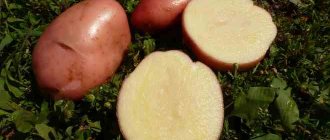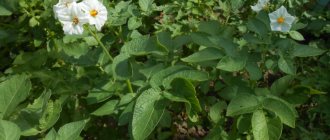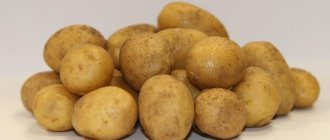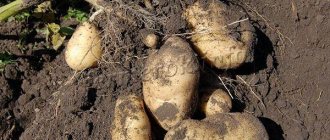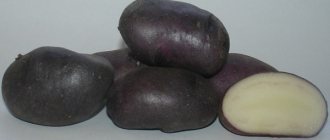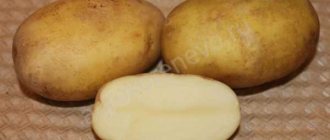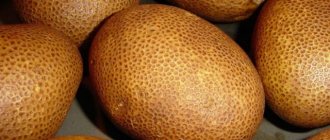Potatoes are considered an integral part of the diet for daily consumption. Description of the Banba potato variety, photos and reviews indicate the promising capabilities of the crop. The variety is grown both for commercial purposes and for home use. It is beneficial to grow it in any type of soil, because the plant is resistant to many diseases.
Description of the Banba potato variety
Dutch and Irish scientists obtained high-quality Banba potatoes through selective trials of crossing nightshade varieties. During the experiments, potato seeds of Estima and Sleni were used. The variety is young and appeared on the Russian market several years ago. In a short period of time, it managed to gain popularity among gardeners and gardeners due to its taste and unpretentious agricultural cultivation techniques.
Domestic production of the variety is planned for 2018-2019, so planting material will be imported from Europe for several more years. Mature bushes reach a height of 50-60 cm. The foliage is dark green, the stem turns yellow closer to the base of the roots. The leaf has a regular shape and is slightly corrugated; the flowers are white and have a long flowering period. In terms of fruiting time, it belongs to the mid-early varieties.
The variety produces a high-quality and tasty harvest. The tubers are smooth, oval or round-flat in shape. Banba potatoes are resistant to mechanical damage. Commercial yield is 90-95% of all potatoes. The tubers have from 5 to 12 shallow eyes. There are elongated tubers. The peel is thin, dark yellow or light brown. The pulp, which is high in starch, is pale yellow in color.
Planting and growing potatoes of the Solnechny variety
Cultivation of the crop is carried out in a standard way. Caring for tubers begins before they are planted in open ground.
The preparatory stage takes 30 calendar days and includes three points:
- Inspect the planting material for damage.
- Tubers left for planting are stored in a dry, well-lit and heated (at least 15 ° C) part of the house or in an appropriate utility room. One hundred gram potatoes are left whole for planting. Heavier root vegetables are cut into several parts.
- Before planting, potatoes are treated with chemicals - growth stimulants.
The land intended for planting potatoes of the Solnechny variety must be fertile, saturated with oxygen, and enriched with organic and mineral fertilizers. In autumn, the soil is loosened, feeding with wood ash and humus. In spring, loosening and fertilizing are repeated.
Important! Spring fertilization and digging are necessary to destroy fungal infections and larvae of garden pests.
Planting potatoes in open ground begins after the air outside warms up to 16 °C and the soil to 10 °C.
If the gardener doubts that warm weather has established itself everywhere and expects unexpected frosts or cold seasonal rains, planting potatoes is postponed. Hypothermia of tubers can cost the harvest.
Planting material is planted (maximum depth of planting holes 10 cm) so that the two nearest holes are at least 35 cm apart. The recommended row spacing is 70 cm. The bottom of each hole is sprinkled with wood ash.
Caring for potatoes of the Solnechny variety consists of systematic watering and loosening and destruction of weeds, as well as periodic application of fertilizers.
Potato care
Plants at the flowering stage are watered generously, but in moderation. Most amateur gardeners, as well as farmers who grow potatoes professionally, resort to drip irrigation of potato beds.
Note! Drip irrigation eliminates the risk of putrefactive infections and allows you to supply the plants with sufficient moisture.
Watering must be followed by loosening the soil. In this way, the seedlings will be saved from oxygen starvation.
The first fertilizing is applied after the seedlings grow up and their tops reach the 20 cm mark. Rare potato bushes that do not have time to reach their fellows are also fertilized. Vegetable growers prefer to feed potatoes with nitrogen-containing substances or ammonium nitrate.
The second feeding is carried out in mid-summer. Potatoes are treated with bird droppings diluted with water in a ratio of 1:10. The solution is poured into the rows.
Experienced vegetable growers try to time summer feeding to coincide with the very beginning of the flowering phase, when young shoots are especially in need of nutrients.
The third feeding is applied at the end of summer or early autumn. This time they use minerals containing phosphorus and potassium.
Weeding is carried out when necessary to remove weeds. They try to pull out the weeds along with the roots, after which the bed is mulched with straw or peat soil.
Hilling up would be appropriate at least three times a season:
- the first time, after the tops of the seedlings grow to the 10 cm mark;
- The second and third hilling is carried out together with the application of fertilizers - in the middle and end of summer.
Harvesting begins when the potato bush becomes spreading and the branches fall to the ground.
Note! If digging is carried out with a shovel, the working surface of the garden tool is inserted into the ground, slightly retreating from the intended location of the tubers.
Immediately after digging, potatoes are not removed from the beds.
Harvesting takes place at the end of summer
The crop is left outside for a couple of hours to dry naturally. After this, the vegetables are sent for storage in a well-ventilated, dry room.
Storage features and shelf life of the Solnechny variety
The harvested crop is stored in a wooden container in a dry and cold cellar. The keeping quality of Sunny potatoes is 94%.
Since potatoes of the Solnechny variety cannot resist the M virus, vegetable growers exclude hoeing (harrowing) from the list of care activities, and treat row spacing only when necessary. This reduces the likelihood of the virus spreading.
Each vegetable grower chooses for himself whether to plant this variety or not. In any case, you must first weigh all the pros and cons and evaluate resistance to common ailments in order to be sure to reap a rich harvest.
Taste qualities of Banba potatoes
Tasters give 4.9 points for the taste of the Banba potato variety on a five-point scale, which emphasizes the quality of the tubers. The potatoes taste without bitterness, although the dry matter is present in 20% content. The flesh is crispy and difficult to cut. The variety is great for frying, French fries, and chips. After heat treatment, the tubers do not fall apart, sometimes the skin cracks, but the taste does not deteriorate.
Flowers and sprouts contain alkaloids, so they are used in traditional medicine only in fresh form. Mashed potatoes are used for diet, heart disease, and disruption of the gastrointestinal tract. The raw Banba variety is used for compresses for sore throat, leg pain, and gastritis.
Important! Due to the high presence of starch, potato tubers are applied to areas of fresh burns, which will prevent the appearance of blisters and relieve most of the redness.
Features of care
Potatoes of the "Banba" variety require minimal care and, according to some data, show good yield even when grown by beginner, inexperienced gardeners. Knowledge of the basic characteristics of the plant and adherence to agricultural technology will help ensure high potato yields and obtain tubers with high quality characteristics.
- Indicators of the size of the harvest and its quality strongly depend on the water-physical properties of the soil, as well as its fertility.
- The soil should be loose, air- and water-permeable, moisture-absorbing, highly cultivated, which is typical for sandy, sandy loam, light and medium loamy soil.
- Minimum soil density in the tuber formation zone contributes to a better supply of oxygen to the root system of plants and has a beneficial effect on yield.
- The application of mineral fertilizers is important in the first half of the potato growing season, and phosphorus and potassium components should be applied at the digging stage.
- Fertilizing with nitrogen-containing fertilizers is carried out at the stage of the last inter-row cultivation of potato plantings.
- The main, most abundant watering, despite the drought resistance of the Banba variety, should occur during the period of budding and flowering.
- To increase the area of soil required for tuberization, several hillings of potato tops should be carried out.
Spraying potatoes during the growing season:
- the first is preventive;
- the second at the phase of closing rows - budding;
- repeated – in two weeks.
It is recommended to use products such as Fitosporin-M and Alirin-B.
Pros and cons of the variety
Based on reviews and characteristics of the Banba potato variety, gardeners note the following disadvantages:
- Tubers growing in the sun quickly turn green and are not suitable for consumption;
- low resistance to late blight of tubers;
- does not tolerate frost well.
Advantages of Banba potatoes:
- drought resistance;
- immunity to late blight of foliage, scab;
- good taste;
- universal use of tubers;
- long shelf life;
- transportability over long distances;
- not damaged during harvesting;
- nutritious tubers, the presence of vitamins C, B6;
- marketable harvest.
Description and characteristics of the variety
This potato variety, named after the local legendary Queen Banba, was created not so long ago in Ireland with the participation of Dutch breeders. As a result, the early-ripening Banba potatoes turned out to be high-yielding, with extremely tasty fruits and excellent presentation, not afraid of drought and most potato diseases and pests.
Characteristics of tops and tubers
The tops of adult potato bushes of the described variety reach a height of 60 cm, have dark green foliage and a slightly corrugated shape and a stem that turns yellow at the base. The flowers are white and bloom for a long time.
Oval or flat-round tubers reach a weight ranging from 100 g to 150 g. With proper care, a bush of the Banba potato variety can produce up to 6 kg of root crops. The potatoes are covered with a thin dark yellow skin, and the flesh is light yellow in color, has a high starch content and excellent taste, which experts rate no lower than 4.9 points out of 5 possible.
From the point of view of consumer qualities, this potato belongs to the culinary type AB and is well suited for frying, making chips and French fries, and for boiling, during which the tubers do not become overcooked and do not lose their taste.
Ripening time
Belonging to the fast-growing varieties, Banba potatoes are harvested in a short period of ripening, lasting only 80 to 85 days.
Disease resistance
The immune system of this potato variety at the genetic level determines its resistance to common scab, blackleg, late blight of tops, and potato canker. But it does not resist tuber late blight so effectively.
Planting and caring for Banba potatoes
Irish varieties adapt quite well to all types of soil and growing conditions. In any climatic zone of Russia, the Banba potato quickly adapts and in any case will produce a large harvest. However, to obtain a high-quality and large harvest, agrotechnical rules for planting potatoes must be followed.
Selection and preparation of a landing site
In certain regions of the country, soil quality leaves much to be desired, so acidic, saline or neutral soils must be fertilized frequently. Otherwise, the potatoes will not develop well. Banba grows well on loam and black soil. The seating area should be well lit by the sun or partial shade will do. The landing site must be fenced. Young bushes are very weak and may not withstand the winds. To prevent the variety from degenerating, you need to change the planting location every 3-4 years.
In the fall, the soil is dug up along with superphosphates, which will begin to act only in the spring. Before planting, the soil is dug up deeply and disinfected: sprayed with a highly concentrated solution of potassium permanganate or chemicals. To prevent the solution from scorching the ground and spreading evenly, it is necessary to harrow the soil. Depending on the planting pattern, they make rows, holes, or plant them under a bayonet shovel. The distance between the rows is 30-40 cm, per 1 square. m plant 5-6 Banba potato bushes.
Preparation of planting material
The preparation of the material begins with an inspection of the purchased tubers. Damaged, soft, wrinkled or dried out potatoes are not suitable. To plant, tubers of the Banba variety must be germinated. The rapid appearance of sprouts occurs under constant artificial light. A pallet or box with potatoes is installed in a greenhouse or ordinary room. The eyes should be directed upward. Tubers are sprayed with growth stimulants for 2-3 days.
At low temperatures, potatoes are sprinkled with clay, sand, and the cracks are filled with paper. Germination is done a week before planting. Planting material is ready for planting when the sprouts reach 3-5 cm. For planting, do not take large Banba potatoes; you can take medium or small tubers with a large number of eyes. Without equipment, you can lay the potatoes on sheets of newspaper and cover them with sawdust. In such conditions, spraying is carried out once a day, because sawdust will retain moisture for a long time.
Landing rules
The landing time is selected approximately. The end of May or the beginning of June is suitable, when the soil and air have a constant positive temperature of + 15-20 ° C. However, late planting reduces the yield. Complex fertilizer made from wood ash, onion peels and a small amount of manure is added to dug holes or beds. Only dry slaked lime and compost are added to acidic soils.
The depth of the row and pit is made small - 20-30 cm, because when digging deeply, the soil must be loose on all sides for potatoes. This will not hinder the development of sprouts. The potatoes are planted with their sprouts up at a distance of 25-30 cm. Next, they are sprinkled with soil and the soil is harrowed to level the area.
Watering and fertilizing
Watering begins after 3-4 days of planting. The sprouts have time to acclimatize and begin to grow. In the first month, water 2-3 times a week and monitor the condition of the soil. The soil should not be dry, cracked or waterlogged. After the appearance of young stems, Banba potatoes cannot be filled with water, so watering is reduced to 2 times a week. It is enough to water an adult plant once a week, although in dry weather the number of waterings is increased.
Fertilizing is done when planting, then every 2-3 weeks. Potatoes are additionally fertilized with growth stimulants during the first few waterings. At the time of flowering, the Banba variety is fed with phosphates and a saltpeter solution. Nitrogen supplements have a good effect on the growth of tubers, so a small amount of the substance is added to the soil a week after flowering. A month before harvest, add a small amount of mullein or compost to the soil.
Loosening and weeding
The soil is loosened before each watering and when there is noticeable stagnation of the soil. Next, if necessary, raise the soil for improved oxygen supply to the root crops. Before hilling it is necessary to carry out weeding and loosening. For weeding, use a garden rake or hoe, which will not damage the young Banba potato variety. After acid rain, it is necessary to water the potatoes and loosen the soil. Weeding is done every 2-3 weeks; during watering, residual weed roots are removed.
Hilling
Potatoes of the Banba variety are hilled when the plant stems reach 15-20 cm. Initially, hilling is done for each bush. 2 weeks before flowering, potatoes are hilled in a row. Mulching is done with hay, large or small sawdust. When mulching, watering is carried out once a week - the moisture lasts a long time. Then, with each feeding with dry fertilizer, the bushes are lightly hilled.
Landing
Planting seed potatoes (pre-selected small tubers) begins when the soil warms up to +10-15 and the frosts end. In the middle zone it is April - May.
The tubers are prepared by germinating them for 2-3 weeks. The selected high-quality material is laid out in a thin layer in the light, ensuring a temperature of +12-15 degrees. The day before planting, spray with a stimulant solution.
The length of the sprouts when planting should be no more than 4 cm.
In the fall, the bed is dug up to the depth of a spade (about 30 cm) and compost or humus is added. On poor soils, 10 kg of fertilizer will be required, as well as peat and sand if the soil is heavy. On nutrient soils, 5 kg is enough.
In the spring, they dig up again and apply a little mineral fertilizer.
Between the holes in the rows leave 30-35 cm, and between the rows - 70-75 cm.
Place a little nitrophoska or wood ash in the holes. Ash increases the starchiness of tubers.
Diseases and pests
According to the photos provided by the gardeners and the description of the variety, the Banba potato is under attack:
- Colorado potato beetle;
- caterpillars;
- slugs.
As a preventive measure, the Banba variety is sprayed with Colorado and Tornado chemicals, and Colorado beetles are removed manually. For slugs, use copper sulfate, sulfur or dust. Having immunity to common and powdery scab, potatoes are extremely unstable to late blight of tubers. The appearance of fungal disease is prevented by:
- processing potatoes before planting;
- early planting date;
- crop rotation;
- planting without thickening;
- treatment of adult potatoes of the Banba variety with fungicides;
- in-depth weeding.
Important! At the first signs of disease, you need to remove all infected bushes.
Pests and diseases
The Banba variety is characterized by good immunity. Most often, bushes suffer from pest invasion. Caterpillars, Colorado potato beetles, aphids, slugs, and mole crickets can destroy plantings. To combat them, insecticides are used: “Iskra”, “Fufanon”, “Vertimek”, “Colorado”, “Medvetox”.
Bushes are also sprayed with folk remedies:
- a solution of wood ash and soap, soda;
- infusion of garlic cloves;
- decoctions of onion peels, marigold flowers.
Slugs can be removed manually, and for prevention, crushed chicken egg shells or nuts can be sprinkled next to the potato field. Insects can also be repelled by fragrant herbs. Near the plot, experienced gardeners plant marigolds, coriander, calendula, and tobacco.
Sometimes Banba potatoes can also suffer from fungal infections. Therefore, for prevention it is necessary:
- Treat the tubers.
- Do not plant crops in one field for more than three years in a row.
- Periodically dust the bushes with ash.
- If necessary, treat with fungicides.
Important! If a plant has suffered from late blight, it must be dug up and burned so as not to spread the infection to neighboring bushes.
Harvesting and storage
Potatoes are dug up in early or mid-August. It is not recommended to delay harvesting - the potato skin becomes thick and rough to the touch. Before storing, the crop is allowed to rest and dry in the sun for 3-4 days. The tubers are sorted into those suitable for consumption, sale and waste. Potatoes of the Banba variety are stored in a dry and dark place at a temperature of 0 to + 3-5 ° C. The shelf life will increase if, after sorting, the tubers are treated with a weak solution of manganese and the potatoes are sprinkled with sand.
Features of cultivation
When growing Banba potatoes, standard rules are followed:
- Planting is done in wet soil, after which water is not given until the first flowers appear. Further, watering is carried out only during drought, and water is given 2 or 3 times a week (3-5 liters per plant).
- After a good rain or abundant watering, loosen the soil to facilitate oxygen access to the roots and also to prevent the formation of a dense crust.
- If the soil is fertile, then fertilizing may not be necessary. However, to increase the yield of Banba potatoes, it is advisable to fertilize them with slurry or other organic matter. This is done a week after planting and during flowering.
- With the traditional method of cultivation, hilling is carried out in furrows or ridges. The first time the soil is raked after the sprouts reach 15 cm, and then 2 more times with an interval of two weeks.
The first watering of Banba potatoes is carried out only after the inflorescences appear
Variety "Sante"
A very productive variety of medium ripening (80-90 days) of Dutch selection. It is actively used to create table dishes, in particular for preparing French fries and chips.
The bush grows compact, of medium height, and erect. Due to the high yield, a significant distance must be left between individual plants. The tubers are large, characteristically oval in shape, with a smooth yellow skin and numerous eyes. The pulp is pale yellow in color with a starch content of 10-14.2%, high quality taste.
Potato "Sante" is one of the first registered hybrids with complex resistance to viruses and nematodes.


